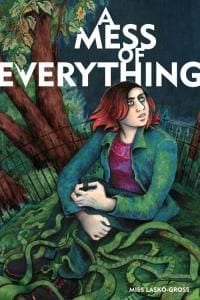
There is a certain satisfaction in reliving the oppression of youth through characters dressed in your own period garb. That’s not to say it isn’t difficult to embrace the angst and disappointments of going through high school with alternate soundtracks and pants. Television shows like Freaks and Geeks or Wonder Years seemingly transcend generational particulars, but reliving an awkward moment in which you let a cooler kid beat you at Street Fighter 2 Turbo just to gain favor takes adolescent failure to a personal 1994 ‘why do you always pick Chun-li’ level. Through Miss Lasko-Gross’ second snapshot memoir A Mess of Everything, she reconstructs her outsider coming of age in the Clinton era.
When I say outsider, I don’t mean the cool alternative kids who played in a Nirvana cover band at the jock parties. I mean those highly intelligent 17-year-olds who, after recognizing the commoditization of rebellion in the limits of suburbia, found themselves making cinnamon rolls in a class for the learning disabled with a kid named Alfred who kept asking if he could touch their hair and shoes, while another classmate would freak out at the sound of cats. Even though those unfortunate classmates are from my own high school experience, Lasko-Gross brings us back to moments like those through her personal narrative, using a dark and biting humor that both self-deprecates and pokes fun at alterna-teens along the way.
Each section of the book addresses what amount to major themes from after school specials turned inside out. Respect for adult authority becomes ‘No More Shakespeare’, a nine panel treatise on the culture industry of high school literature classes with a punch line: “In the end school is a factory for good ‘quiet’ citizens.” Another section titled ‘The Decoy’ recounts an experience of almost getting caught shoplifting due to a negligent friend, but still getting away. The life lesson is not about stealing, but about careless friends and the naiveté of mall security.
One of the most thoughtful pieces in the book, Unsaid, offers a short look into the intersubjectivity of friendship and how close we can feel to another person through yelling a song together while doing little more than driving around. Because even though complex social systems have been set up to ensure most of our teenage years were spent humiliated, it was also a time when we learned the closeness of friendship so many people forget when looking for more adult relationships to fill the loss of the young bored winter.
Alienation, failed romance, and bathroom catastrophes provide for mixed humor when placed in a narrative of losing friends and eating disorders. The art pulls everything together wonderfully, however, and each section receives a beautiful splash page or panel with an embedded title to welcome you into the vignette. Her world closes in on you as complex webs emerge in the backgrounds of more frantic scenes. The colors never bring us spring, let alone summer, in this melancholic suburban landscape. Her palette is mostly made of grays and blues, and her world sits at the edge of grimness, always looking like it is about to rain. And even when things start to go right, it’s still raining.
Though Fantagraphics has billed A Mess of Everything as the second part of a trilogy, it stands well alone for new readers of Lasko-Gross’ work, like myself, who want to skip straight to the unique uneasiness of the teen problems we carry through adulthood. As high schools become more and more like prisons and techniques of humiliation take on new forms, it is nice to reminisce upon the particularities of this era. The only thing missing was the sadistic part-time job boss, but perhaps he will make an appearance in volume 3, walking around and pointing to each spot we missed when mopping.
